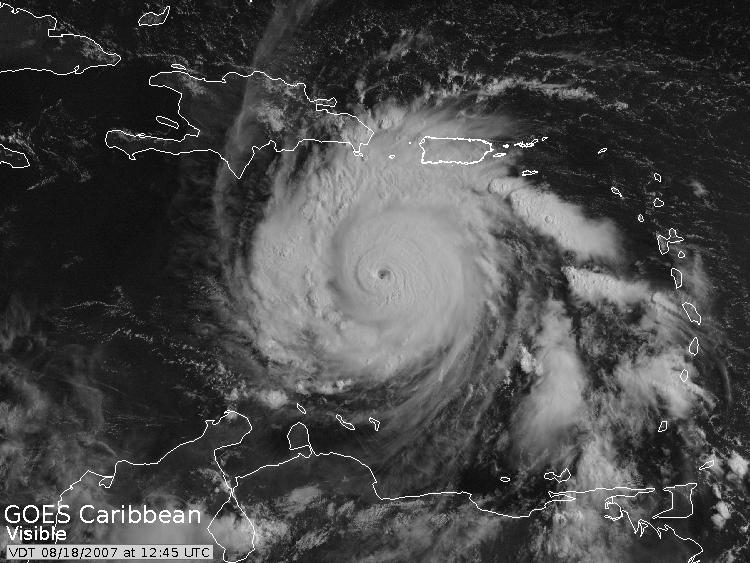
Section Branding
Header Content
A Hurricane By Any Other Name Would Still Be As Stormy
Primary Content

In “Tropical Disturbances, Depressions, and Storms: Oh My!”, I highlighted the spectrum regarding the four main tropical weather features. Of the four, only two will receive names: tropical storms and hurricanes. (Meteorologists give disturbances and depressions a different and much less exciting designation, which is described in detail here by the Atlantic Oceanographic and Meteorological Laboratory.)
Once a tropical cyclone exhibits maximum surface wind speeds of 34 knots (39 mph), it receives the tropical storm designation and a name. The history of naming tropical cyclones is rather colorful – in the early 1900s, an Australian weather forecaster named storms “after political figures whom he disliked” (Source: AOML). Imagine publicly denouncing an ill-favored politician by accusing them (through the guise of a storm, of course) of “’causing great distress’ or ‘wandering aimlessly about the Pacific’” (AOML)!
Australian weather forecasters were not the only ones who personified tropical cyclones. In the 1940s, US Army Air Corp and Navy forecasters unofficially gave the tempests women’s names, in “honor” of their girlfriends or wives (AOML). (Growing up, I always thought that 1965’s Hurricane Betsy was an excellent way to describe my younger sister, but she’s quite lovely now and I’m actually jealous that I do not have a tropical cyclone named after me.)
From 1953 through 1979, tropical storms and hurricanes were officially given women’s names; by 1979, the naming of tropical cyclones became an equal-opportunity affair as men’s names were added to the list. Today, tropical storms and hurricanes are named alphabetically, and they alternate between men and women’s names. The National Hurricane Center keeps a running list of the current and future names of tropical cyclones, which can be accessed on their website.
Once a tropical storm exhibits wind speeds of 74 mph or greater, it receives the hurricane designation but retains its assigned name. The hurricane is also further classified within the Saffir-Simpson scale, which gives an estimate of the hurricane’s intensity based on potential flooding and property damage.
Saffir-Simpson Scale
| Wind Speeds | Notable Storms | |
| Category 1 | 74 – 95 mph (64 -82 knots) | Hurricane Gaston from 2004 |
| Category 2 | 96 – 110 mph (83 – 95 knots) | Hurricane Ike from 2008 |
| Category 3 | 111 – 130 mph (96 – 113 knots) | Hurricanes Rita and Wilma from 2005 |
| Category 4 | 131 – 155 mph (114 – 135 knots) | Hurricane Charley from 2004 |
| Category 5 | 155 mph or greater | Hurricane Camille from 1969 and Hurricane Andrew from 1992 |
Hurricanes that are classified as category 3, 4, and 5 storms are considered “major hurricanes” – widespread catastrophic damage is associated with these storms. While 21% of landfalling hurricanes fall under the "major hurricane" classification, these monster storms are responsible for 83% of all hurricane damage (Source: AOML).
Hurricanes bring a powerful punch, and not just with their incredibly high wind speeds. Along the coast, storm surge provides the greatest danger to life and property (storm surge is the “abnormal rise of water that is generated by a storm, over and above the predicted astronomical tide,” as defined by the AOML). Further inland, torrential rains, flooding, and tornadoes are associated with these storms as well. In fact, 2005's Hurricane Katrina spawned 18 tornadoes across Georgia within an 8 hour time span, with 14 of them occurring in counties north of Macon (Source: NWS in Peachtree City).
Although Georgia has not experienced a direct landfall from a hurricane since 1979, the state is still frequently affected by hurricanes and tropical storms as they make their way inland from Florida and Alabama. Abiding by all weather watches and warnings is paramount in order to avoid property damage and personal injury during these weather events. Most importantly, be sure to have an action plan in case you have to evacuate, and also create emergency disaster kits for your office, home, and car so that you are well prepared whenever severe weather strikes.
In the meantime, I’d love to hear your hurricane stories! Did you experience Hurricane Bob in 1979 – the first ever “man-icane”? While I agree with comedian Lewis Black that the name “Bob” is not a match for a hurricane (seriously, how intimidating is the name “Bob”?), he still was a destructive “man-icane” – one person died and the hurricane caused $20 million (in 1979 dollars - $64,650,000 in 2011 dollars) worth of damage. Have you ever underestimated a tropical storm or hurricane? Or did you experience the opposite – expect the worst and then wonder why you experienced nothing more than a light breeze?
I look forward to hearing your responses! Until then, happy storm spotting!
Related Posts You May Like
Tour Through The Hurricane Hunters' Airplane!
If A Storm Brews In The Tropics, Is It Really A Tropical Storm?
Tropical Disturbances, Depressions, and Storms: Oh My!





